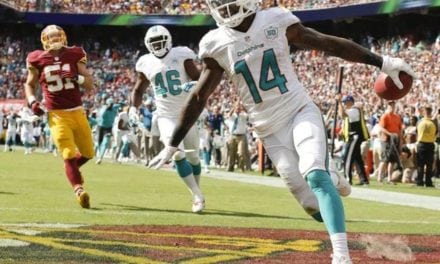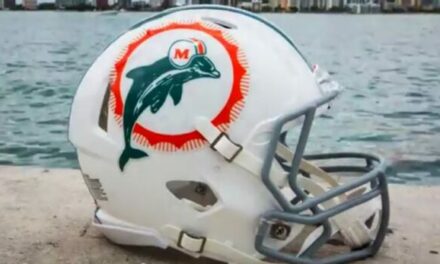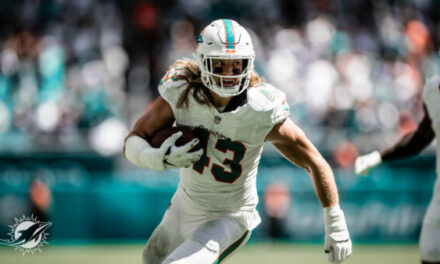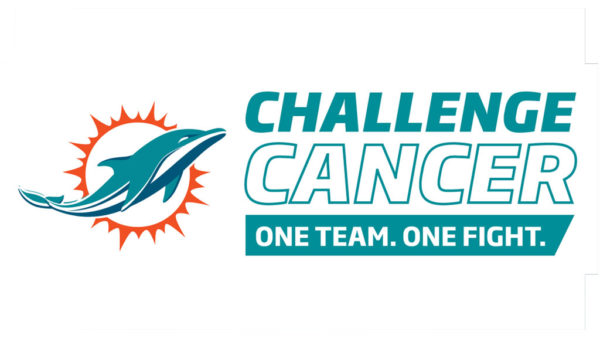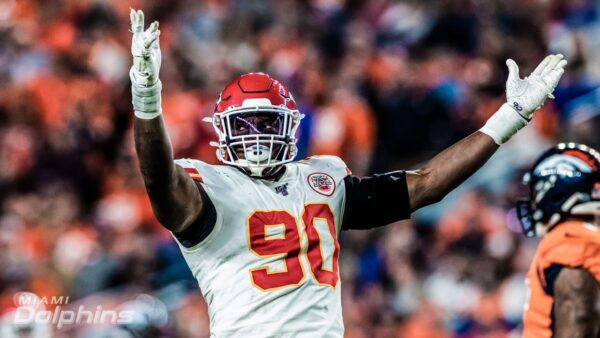
Miami had a big, big offseason. There’s no denying that. Tua Tagovailoa dominated most of the headlines and was the crown jewel of the Draft, and rightly so. Miami landed some big fish free agents on defense on day one of Free Agency, landing arguably the best free agent available in Byron Jones, along with underrated stud Kyle Van Noy and Shaq Lawson. Those are the big names that’ve been talked about by most Dolfans this offseason. But, I think most are sleeping on DE Emmanuel Ogbah. I’ll show some examples of his run-stopping prowess, which is much needed after last year’s edge players were pushed around too frequently. I’ll show examples of his pass-rushing ability in comparison to Miami’s crop of DEs last year. Finally, I’ll cover what I think his role in the defense will be and why he’s been slept on thus far.
Run Defense
If you’re a fan of the “Move the Sticks” Podcast with Daniel Jeremiah and Bucky Brooks, you’re likely to remember this. On April 1st Daniel Jeremiah detailed a presentation he heard while as a scout with the Baltimore Ravens. One of their members had been with the organization since Bill Belichick had coached the Browns. Remember, the Browns became the Ravens. Belichick’s defensive tenants, many of which are still true today. As it relates to defensive ends, Belichick said:
– He wants to take away the middle of the field; don’t let the offense run or pass inside.
– Pressure the QB up the middle, force them outside.
– Defensive ends specifically – all-around player, big, strong, and can run. Hardest to find.- Rather have a big strong guy to stop the run first; can substitute in for pass-rush.
We’ve seen this with the Patriots over the years with guys like Richard Seymour and now Lawrence Guy. In 2018, when Brian Flores ran the defense for the Patriots, they used Trey Flowers, Deatrich Wise, Adrian Clayborn, and Keionta Davis. Other than Trey Flowers at 6’2” 265lbs, Clayborn, Davis, and Wise are all 6’4” and 275lbs+. If you look back at Miami’s roster last year, none of their defensive ends hit those marks except for Jonathan Ledbetter who spent most of the year on IR.
Enter Emmanuel Ogbah. He’s a big man at 6’4” 275lbs with 35.5” arms and a wingspan of nearly seven feet. And he can move, clocking a 4.63 forty time at the Combine coming out of Oklahoma State. He fits the bill of being a big, strong guy who can stop the run, and is built similarly to current Patriot Deatrich Wise.
Ogbah notched a 67.4 run defense grade from Pro Football Focus last year. But I think he’s better than that grade indicates. With such length and strength, he’s able to set a hard edge and force runs to go outside where your typically faster players – linebackers and safeties – can make stops. Miami didn’t fare well last year in that regard finishing 27th in the NFL in run defense, giving up just over 135 yards per game on the ground, giving up 4.5 yards per carry. Yikes!
Ogbah should be able to help fix at least one side of the defense this year. Let’s take a look at a few examples of his edge-setting ability.
Takes on a down block like it’s not there. pic.twitter.com/0P7yfZ46cy
— Kevin Dern (@KevinMD4) July 20, 2020
Let’s start in week four with the Chiefs against Detroit. Here we see Ogbah lined up at LDE in a 6-technique. Detroit, for some reason, is going to try to down block Ogbah with a receiver just outside the TE, who is off the ball. Ogbah recognizes the TE and RT pull, and gets his hands up to take on the down block. He uses his long arms to extend and lock out against the receiver and just muscles him away. We get to see his speed as he tracks down Kerryon Johnson for a three yard loss. Okay, okay you got me. This isn’t really setting the edge, but I wanted to highlight his athleticism and awareness when dealing with space. Pretty good.
Short yardage stop. pic.twitter.com/A4EdmyI2Jd
— Kevin Dern (@KevinMD4) July 20, 2020
The very next week against the Colts we see the Chiefs in a key 3rd and short. They’re in an under look with Ogbah at LDE in a 6-technique against Colts TE Mo Alie-Cox. Ogbah has support on the edge with Tyrann Mathieu and the corner, so he’s able to read run at the snap and jolts Alie-Cox upright. While it’s not quite a good rep in two-gapping (B & C since DT steps inside), he’s able to fight off Alie-Cox and gets an arm free to help stop Marlon Mack short of the first down.
More Ogbah pic.twitter.com/zIVszy2YFQ
— Kevin Dern (@KevinMD4) July 20, 2020
This example is just vicious. This is week 9 against the Vikings. Again we see Ogbah at LDE, this time in a 5-technique. He reads Brian O’Neill’s run set and just destroys him at the point of attack while maintaining outside leverage to set the edge. He and Khalen Saunders combine for the TFL. Reps like this are what we need in Miami.
Ogbah setting the edge. pic.twitter.com/vktgdCV46F
— Kevin Dern (@KevinMD4) July 20, 2020
The next week against Tennessee, Ogbah’s last game of 2019 is next. Here we’ll see him initially in a 5-technique off RT Jack Conklin. The Titans motion a TE and Ogbah tilts just slightly to line up in a 6-technique. At the snap, he’s able to read the line all moving to his left so the Titans can try and set up an outside stretch zone run with Derrick Henry. Ogbah has other ideas and is able to win with hand placement. He gets his right arm inside of Conklin’s hands to his chest plate and is able to knock him off course. It looks like Ogbah is about to lose outside leverage, but he recovers and is able to keep fighting with his hands and eventually rips the right arm through Conklin and stays outside enough to bring down the runaway freight train that is Derrick Henry for a short gain. While it’s not a run stop (within 2 yards of the LOS), he’s able to almost solely prevent this from being a potential first-down run.
While I don’t have any reps to showcase here, Kansas City also used Ogbah a lot at RDE to help against the run and he’s very capable of playing both sides. There are a few really nice reps in the video of him mic’d up against the Vikings that I reference shortly. Watch that to see how he sets the edge at RDE.
Pass Rush
Emmanuel Ogbah received a 62.6 pass-rush grade from Pro Football Focus. Take that any way you like. Per PFF, it’s very average. Personally, PFF grades often feel like they don’t jive well with what I see on tape. After last year’s Dolphins had miserable pass-rush numbers (23 sacks, last in NFL), I wanted to do a quick study on Emmanuel Ogbah. To be fair, I included Vince Biegel and fellow newcomer Shaq Lawson and compared all of them to last year’s sack leader Taco Charlton. I wanted to see how Ogbah fared as a run-stopper and as a pass-rusher, and what his role in Miami’s 2020 Defense might be.
For starters, with the way Brian Flores’s defense works, there’s often some sort of pass-rush game going on. A twist, Tom game, looping from the strongside edge to the backside A or B gap. Something is going on, and that doesn’t always equate to getting to the quarterback quickly. And, to me, that seemed to play out often last year, even when Miami sacked a quarterback – it took a while for it to happen. With that in mind, I wanted to see just how quickly those four players listed above got to the quarterback. I tracked all of these players sacks from 2019 and recorded their position, alignment technique, rush type with any moves (i.e. club rip, swim, swipe, etc.), time to contact of the QB, and any notes about the play (i.e. forced fumble, scramble).

Note: To avoid subjectivity when possible, I measured the time from the snap to the first contact of the quarterback. I measured each sack for each player five times with a stopwatch and took the average to cut down on user error. I’d have done it 10 times each, but my five-month-old had other ideas! So, yes, if you do this study yourself, you may get slightly different times than I did.
I found that the average time from snap to contact was 3.91 seconds. As you can see in the data, this is due in large part to Taco Charlton’s times. If we don’t account for Taco Charlton’s times, the mean becomes 3.44 seconds. Of Emmanuel Ogbah’s 5.5 sacks from 2019, all of them have a quicker time to contact than the 3.91 average, with his slowest time coming in at 3.67 seconds, and 4.5 sacks are still quicker than the adjusted mean. Some interesting notes from the study:
Average time from snap to contact:
– Ogbah – 3.20 seconds
– Lawson – 3.59 seconds
– Biegel – 3.63 seconds
– Charlton – 5.29 seconds
Top five times from snap to contact:
– Lawson – 2.75 seconds
– Lawson – 2.77 seconds
– Ogbah – 2.78 seconds
– Charlton – 2.79 seconds
– Lawson – 2.86 seconds
Bottom five times from snap to contact:
– Charlton – 8.36 seconds
– Charlton – 7.36 seconds
– Lawson – 6.53 seconds
– Charlton – 4.25 seconds
– Biegel – 3.96 seconds
Obviously, this is just the sampling of data that we can take from my brief study. What I think it illustrates best is that when Ogbah’s getting to the QB, he’s getting there quickly, compared to his new teammates and Taco Charlton from last year. In watching the reps, Ogbah is has a much better plan for getting to the quarterback than the departed Taco Charlton. We’re not going to miss Charlton’s sacks. Charlton had two on QB scrambles when they could have gotten the ball away, and two other reps where he generally wasn’t getting to the QB quickly. Only two of his sacks registered above the mean of 3.91 seconds.
For Ogbah, all of his sacks came when he was aligned as a LDE as a 5-technique DE once, wide-5 technique four times, and as a 7-technique DE. I think that’s where his home will be in most passing situations. More on that in a minute. One rep I especially want to highlight is his final sack of the season in Week 10 against Tennessee. This sack put him in the team lead for the Chiefs at the time, but he suffered a torn pec muscle in this game and missed the rest of the year. Here’s the play against Tennessee:
Ogbah with a sack! pic.twitter.com/DhBrfPxFvp
— Kevin Dern (@KevinMD4) July 20, 2020
What’s appealing to me here is the pass-rush game the Chiefs used with Ogbah. He’s lined up in a wide-5 technique. Both DTs slant toward the field side of the formation allowing Ogbah to loop into the field side A gap untouched and hauls in Ryan Tannehill with his 35.5” arms for a sack. It’s appealing for a number of reasons:
1) Ogbah is 6’4” 275lbs with a wingspan of 83.88”. And he moves like that!
2) If you’ve watched Brian Flores’s defense from back in New England, they ran this game a lot (see Van Noy in 2018 AFC Championship Game)
3) Given Ogbah’s size and play strength, I think we can see him doing some of the “dirty work” the DTs do on this play to free up someone like Kyle Van Noy. So ideally, Ogbah can fill multiple roles in pass-rush games. That’s valuable in this defense.
Another point of emphasis I’d like to call out is that Ogbah’s Defensive Line Coach in Kansas City was Brendan Daly. Daly was with the Patriots from 2014-2018 and served as a Defensive Line Coach therefrom 2015-18. If my memory serves, I believe there were rumors that Brian Flores was going to try and hire him when he was first hired. You’ll notice Daly also has the title of Run Game Coordinator in KC. Hmm.
But where I’m going with this is that Ogbah is good at level rushing. This means that he doesn’t rush past the quarterback; he keeps his rush up to an even plane with the QB. We saw Cameron Wake and Robert Quinn get sacks in Miami, but how often did we see QBs step up and avoid them? They weren’t practiced level rushers, and part of that was the style of defense Vance Joseph and Matt Burke asked them to play, but both players needed to be better at level rushing at appropriate times.
Ogbah has a pretty natural feel for this, and even if he’s not getting sacks, he’s able to collapse the outside of the pocket without giving up a lane for a quarterback to take off scrambling. With powerhouse QBs in the AFC like Patrick Mahomes and Lamar Jackson, that skill could prove very valuable in time.
Here’s a clip of Ogbah from when he was mic’d up last year against Minnesota with Brendan Daly telling him to level rush and then Ogbah stopping his rush parallel to Kirk Cousins against the Vikings left tackle Riley Rieff. While Cousins isn’t a mobile threat, if Ogbah were lined up against a Russell Wilson, Aaron Rodgers, Jackson, or Mahomes, by leveling off, he’s able to play outside or close the gap between the left tackle and left guard if the quarterback were to take off.
(I tried copying this at the correct timestamp, but if it doesn’t work, go to the 2:41 mark in the video.)
In 10 games, Ogbah recorded 5.5 sacks and 27 total pressures in pass-rush work. Comparatively, both Shaq Lawson and Vince Biegel both played 15 games last year and recorded 6.5 sacks and 38 pressures and 2.5 sacks and 34 pressures respectively. I think it’s safe to assume that had Ogbah kept up his pace for another five games, he’d have had more sacks and pressures than both Lawson and Biegel. And that’s on top of his run-stopping ability!
For a breakdown of Ogbah’s sacks, you can check out this piece my good buddy Travis Wingfield wrote for the team back when Ogbah signed: https://www.miamidolphins.com/news/emmanuel-ogbah-2020-nfl-free-agent-analysis
Shaq Lawson did show some quick-strike capabilities, but he too also had two sacks on scrambles. What’s more interesting to me here is WHERE Lawson’s sacks come from. He lined up on the right side as a 4-technique DT, 5-technique DE twice, 6-technique DE, 9-technique DE, and on the left side once as a wide-9 technique DE. If you’ve studied up on Brian Flores’s defense, which means looking at what he called in 2018 when he was the de-facto Defensive Coordinator for the Patriots, these alignments are similar to where they used Trey Flowers. I’m not saying this will be a like-for-like situation, but I think Shaq Lawson very well could be used in that role.
As mentioned, Vince Biegel had 2.5 sacks and 34 pressures in 2019. He was pretty productive and held a key role in the Dolphins defense throughout the season. I think that now with Ogbah, Lawson and Kyle Van Noy in the fold, Vince Biegel is likely in danger of losing some of those snaps on the edge as Ogbah and Lawson are both more productive pass-rushers, and in my opinion, Ogbah is a better run-defender, despite PFF’s grades (Ogbah 67.4 to Biegel 69.6).
Ogbah’s Role
For starters, I think it needs to be said that while Miami officially listed their defense as a 3-4 last year, and ran it to a large degree when they weren’t in nickel (which they’re in most of the time) the 3-4 only happened AFTER the bye week. At that point they’d lost Jonathan Ledbetter, Avery Moss got dinged up in the game against Washington and trying to execute four-man lines didn’t make much sense until they settled on using Biegel almost exclusively as a Rush LB on the right side, which is to say essentially as a stand-up DE. But, if you look at the snaps during the first four games, while they weren’t pretty, I think it’s a better representation of what Brian Flores wants to do. Consider the following. While running the Patriots defense in 2018, their most-used formations on defense were as follows:
4-2 personnel (Nickel) – 307 snaps
3-3 personnel (Nickel) – 226 snaps (this can also be made to look like a 4-2 front)
3-2 personnel (Dime) – 162 snaps
4-3 personnel (Base) – 97 snaps
Those were their top four formations used. And with only 300+ snaps in the most used formation, you can bet there are a lot of variations. But what’s worth noting in my opinion, is that they were in a 3-4 set just 13 snaps that year. Some of those were with a LB, John Simon, masquerading as a 4-technique DE. So is that even really a 3-4? Neither here nor there, but what I look at this info and see is that Miami’s likely going to use a lot of nickel fronts and make an effort to make four-man D-lines out of those fronts.
I think we’ll likely see a lineup that includes Lawson at RDE and Ogbah at LDE with Godchaux and Wilkins inside. I think we’re also very likely to see a lineup that has Kyle Van Noy playing as a stand-up LDE, as opposed to playing Biegel at RDE last year, with Godchaux, Wilkins and one of the two between Ogbah and Lawson at RDE. I think down & distance will dictate those snap counts. But we’re likely to see that more often this year. I also think the football economics show Miami’s intentions here. Van Noy, Lawson and Ogbah have cap hits of $10.9M, $10.3M, and $7.5M respectively in 2020 while Vince Biegel is at $2.1M. In short, they didn’t give Vince an extension. They brought in two free-agent defensive ends and another LB capable of playing on the edge in Van Noy. Then they went ahead and drafted two more defensive ends. They want to see more from Biegel before they commit and based on what they did in free agency and the draft, they’ve stacked the deck against him considerably.
With Ogbah specifically, I think we’ll get to see him predominantly at LDE playing an array of looks from 4-technique out to a wide-9 look depending on down and distance. My guess is he’ll be out there a lot on first downs and obvious run situations. If he’s able to display the pass-rushing capabilities he did for Kansas City last year in Miami, he’s got a shot to be a 3-down player the majority of the time. I’m not saying he won’t get rotated out to stay fresh, because he will, but he’s got a chance to be the number one DE for Miami. I think he’ll also get a fair amount of snaps at RDE in nickel packages where they rotate Kyle Van Noy to an edge position so they can keep Shaq Lawson fresh. My guess is they’ll try to rotate those three with a sprinkling of Biegel and Van Ginkel at first since rookies Jason Strowbridge and Curtis Weaver will still be getting up to speed in what is a complicated playbook.
Obviously, Emmanuel Ogbah needs to stay healthy. But his build and physical attributes, as well as his performance last year all, lend themselves incredibly well to what I think Brian Flores will be running this year. With a shorter deal, two years, I think we’ll see Ogbah go to work in order to collect in free agency once again while he’s still 29 years old. He’s certainly going to have opportunities to do so for the Dolphins and I hope it becomes a scenario where he cashes in. If he does, Miami’s made good on this signing.


